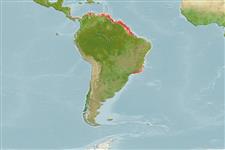Classification / Names
Common names from other countries
Main reference
Size / Weight / Age
Max length : 115 cm TL male/unsexed; (Ref. 40637); common length : 65.0 cm TL male/unsexed; (Ref. 3702); max. published weight: 3.5 kg (Ref. 5217)
Environment
Marine; brackish; demersal; depth range 6 - 70 m (Ref. 3702)
Climate / Range
Tropical, preferred ?; 14°N - 24°S, 84°W - 34°W
Distribution
Short description
Dorsal
spines
(total): 11;
Dorsal
soft rays
(total): 27-31;
Anal
spines: 2;
Anal
soft rays: 8. Greyish to brownish above, silvery below. Upper sides sometimes with inconspicuous minute dark dots. Dorsal fin dusky, its spinous portion black-edged. Soft dorsal fin with dark spots on each ray. Pectoral and pelvic fins as well as anal fin yellowish to orange. Caudal fin dusky. Inside mouth orange. Mouth large, distinctly oblique, lower jaw projecting. Upper jaw with a pair of large canine-like teeth at tip. Chin without barbels or pores. Snout with 2 marginal pores. Gas bladder with a pair of long, curved, horn-like appendages. Sagitta (large earstone) elongate, with a notch on dorsal margin. Soft portion of dorsal fin membranes unscaled except 2 or 3 rows of scales at base (Ref 51721).
IUCN Red List Status (Ref. 115185)
Threat to humans
Harmless
Human uses
Fisheries: commercial; gamefish: yes
More information
Common namesSynonymsMetabolismPredatorsEcotoxicologyReproductionMaturitySpawningFecundityEggsEgg development
ReferencesAquacultureAquaculture profileStrainsGeneticsAllele frequenciesHeritabilityDiseasesProcessingMass conversion
Tools
Special reports
Download XML
Internet sources
Estimates of some properties based on models
Phylogenetic diversity index
PD50 = 0.5000 many relatives (e.g. carps) 0.5 - 2.0 few relatives (e.g. lungfishes)
Trophic Level
4.0 ±0.70 se; Based on food items.
Resilience
Low, minimum population doubling time 4.5 - 14 years (Preliminary K or Fecundity.)
Vulnerability
High vulnerability (59 of 100)
Price category
